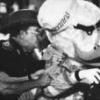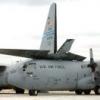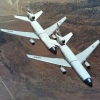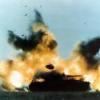I think the General's article raises some interesting possibilities to improve UPT. Better said, I think he is offering some valid ways to improve the transition from UPT to today's modern fighter/attack platforms.
However, I think he's forgetting the basic goal of UPT. We still need to produce pilots with strong foundational skills in basic aviation before we start giving them extra "toys" to play with. The problem with making changes to syllabi and training programs in aviation (military or civilian) is the guys making the changes are usually the old guys who were trained one or more "generations" in the past. They always seem to apply their perspective of how challenging it was to adapt to new technology when most of the time, the young guys do fine. What’s actually harder is being able to go backward once someone had become proficient with new tech.
I've seen it over and over again. F-15 FTU syllabus changes to include advanced subjects and tactics that had traditionally been left until arrival at the ops units. Old guys are highly skeptical and swear the students will flail because when they had to learn the same stuff 10 years into their careers, their ingrained, semi-hardened brains found it a challenge. Surprise - the students eat the shit up and adapt because they don't know any different and they come out the other end more lethal than their instructors were when they were LTs. Airline X decides to put new hires into the right seats of the latest Boeing or Airbus wide-bodies because 1 - there aren't any more 727 Engineer seats to stick newbies into and 2 - they need to fill the seats. Old guys lose their minds again considering the impossible task of learning the ropes at a major airline while getting through right seat training on the modern marvel that is a 21st century airliner with a glass cockpit and all the bells and whistles. Surprise again - new guys (most anyway) from all kinds of backgrounds deal just fine with all the magic that the old guys stared at like a pig looking at a wristwatch.
My point is that new pilots rarely have difficulty adapting to new technology that reduces workload, enhances SA and allows easier human interface. But, once you give them those new toys and train them to use and rely on them from day one, they have no ability to retrograde back to more basic methods. When my airliner computes a descent to hit waypoints at specific speeds and altitudes down track, I do the math and compute my 3:1 descent in my head to make sure the jet's plan is reasonable. It's just a habit developed before I had all the magic. A "child of magenta" probably doesn't have that same habit and may not even have the ability to do it. He's never needed to. So, when Murphy strikes in that scenario or any number of potential problem areas in civilian or military flying, if a pilot has no old school skills and is completely reliant on technology to do his job, he's less capable - period - dot.
I laughed when I saw the side by side picture of the T-X and F-35 cockpits. YGBSM. The fact that both cockpits utilize similar displays and automation isn't going to matter on "Stanley's" UPT sorties when he's trying to figure out how to develop contact flying skills, land out of an overhead, not kill his classmate during a rejoin or shoot an approach to mins. I guaran-fucking-tee that his first sortie in an F-35 is not going to be any easier because he had a moving map or some other sensor display in his T-X while he was still earning his wings. Anyone can go from round dial steam gauges that actually required an instrument scan and some mental challenge to maintain positional awareness and overall SA to the latest, greatest glass cockpit. Going back in the other direction is a far different story. UPT needs to produce pilots with solid, basic aviation skills. Skipping over those by handing Stanley a glass cockpit with a moving map, HUD and whatever other toys are available isn't going to do that. I have no doubt he'll do just fine with them, but there's benefit to learning this job from a basic level first. You produce pilots who don't just take the information presented to them as gospel and blindly follow it - but have the ability to understand how to back it up, QC it to ensure it makes sense and flex to another option if it doesn't. I've seen pilots blindly follow steering bars on a flight director into oblivion because that's all they've ever done. Another is unable to transition to a round dial ADI because they're a HUD baby and it's now tits up. I watched a guy in the sim completely pork a way an approach because he chose not to use DME to the field, mis-interpreted his NAV display and lost SA on where he was. A bearing pointer and DME is a beautiful thing if you know how to use them.
My point is that the General's concern seems to be how can we introduce more shit to Stanley sooner so he'll be more familiar with the F-35 or F-22 cockpit if and when he finally gets that far. I think students will adapt to those environments just fine when the times comes. There may be an opportunity to help begin their transition later in UPT or during whatever we're going to call the IFF phase. But not at the expense of creating a generation of pilots who start out from day one completely reliant on the most advanced cockpit we can field. Maybe the General needs to take a peek at the existing F-15C or A-10 cockpits. They sure as hell would be about 10 steps backwards for a UPT student who just got winged in an F-X and now has to figure out how to fly round dial steam gauges so he doesn't kill himself on his first ILS to mins.
Anyway..... just my old guy two-cents. I still see some value in swinging a weighted bat in the on-deck circle before I'm up.












